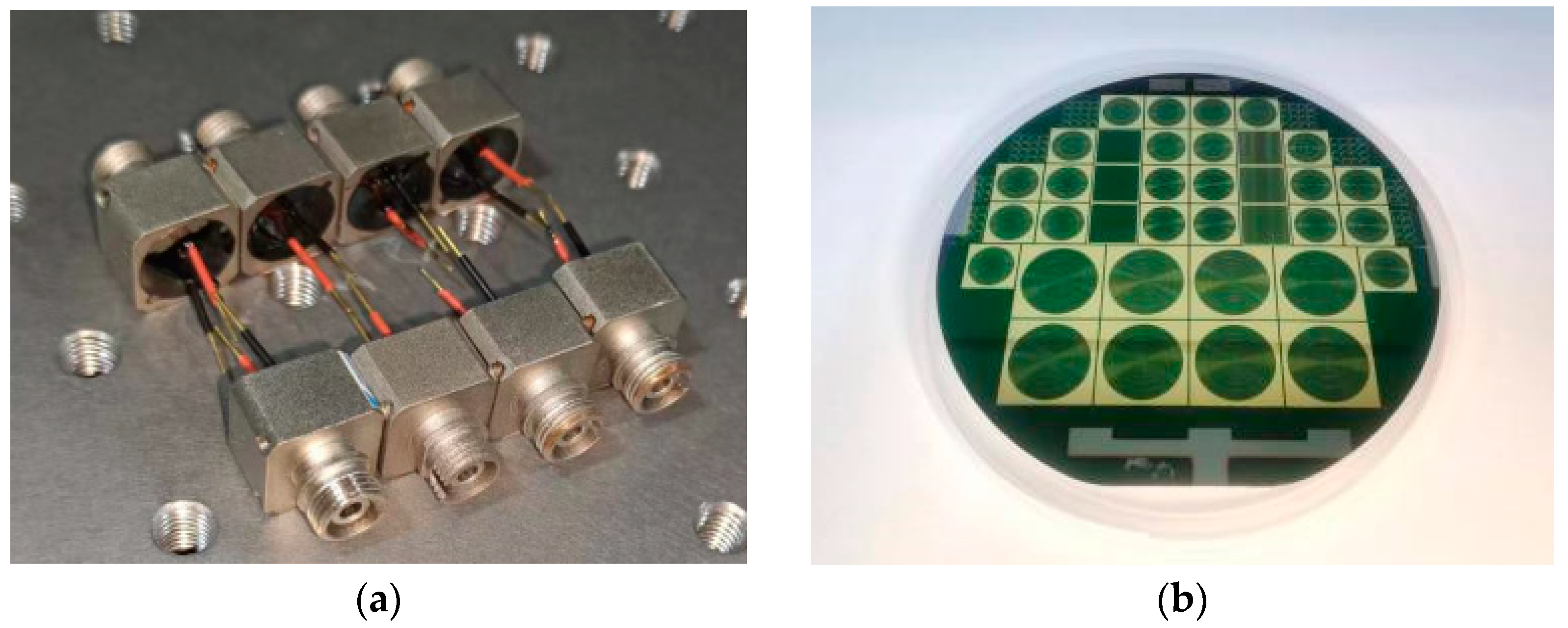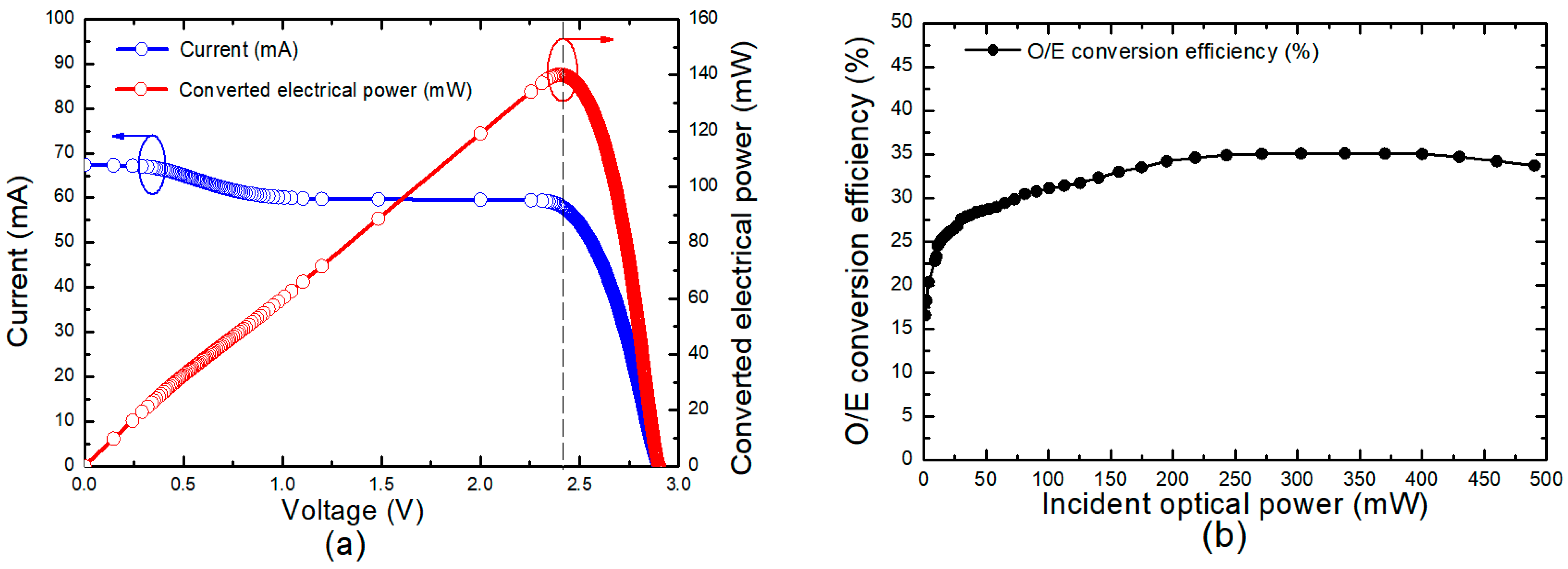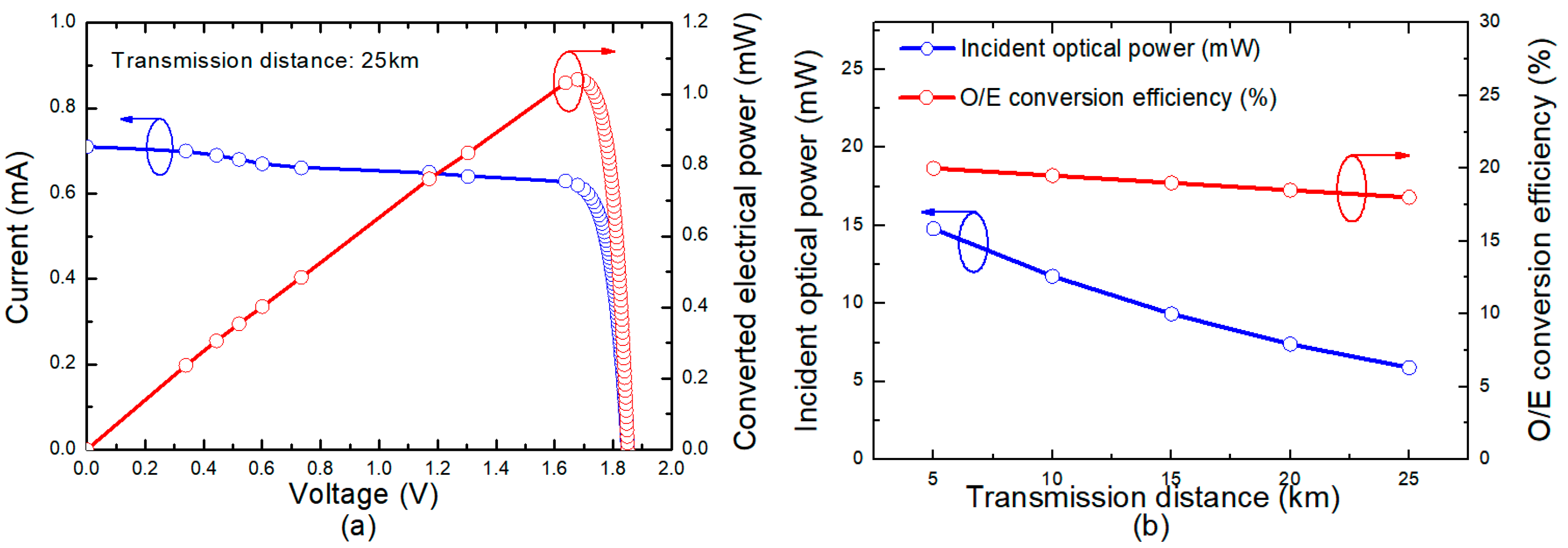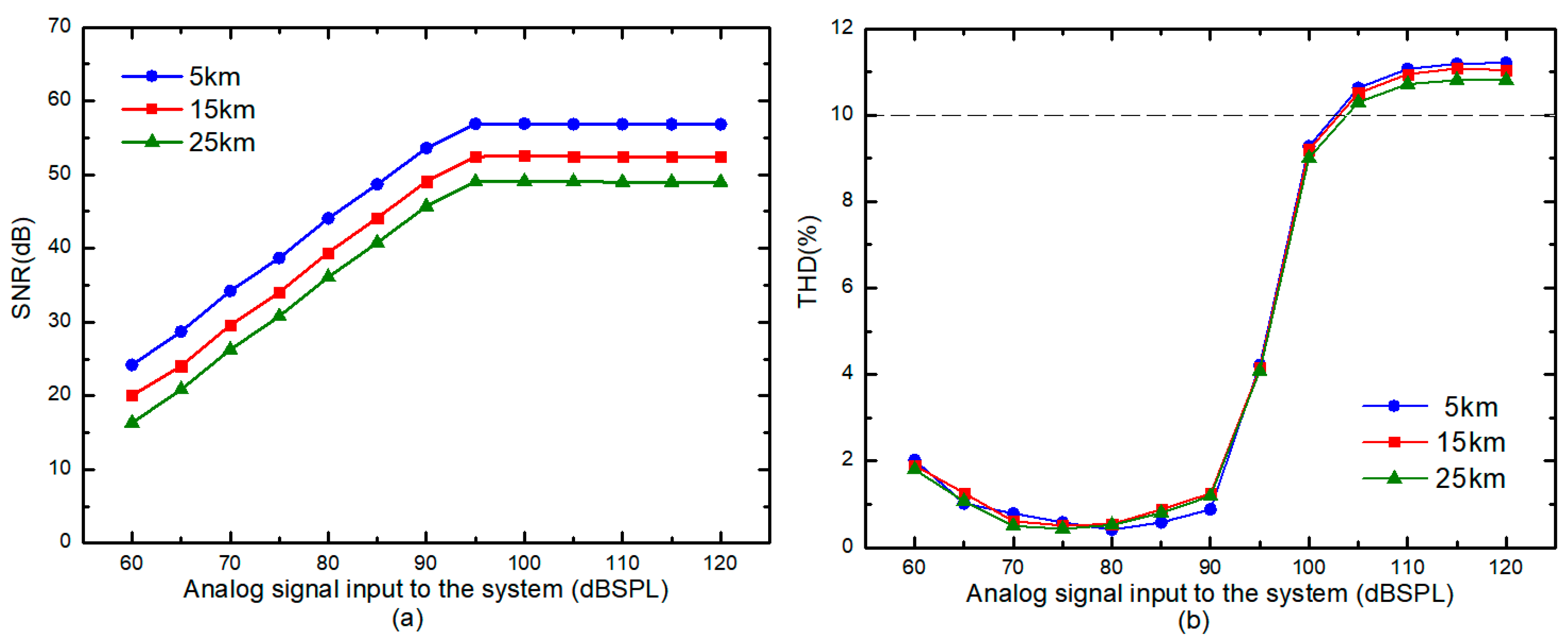1. Introduction
Power-over-fiber (PoF) is an attractive power supply technology with higher insulation characteristics and lower transmission losses than traditional cable-based power supply [
1]. In particular, in some special applications, such as underground mines due to the presence of flammable and explosive gases, it will be safer to use optical fibers with strong anti-electromagnetic interference capabilities for power supply, and communication lines based on PoF will also be more stable [
2]. Based on the existing optical fiber architecture, powering a communication system through PoF links does not require the installation of additional power supply facilities or power lines, which makes the installation of remote communication equipment easier and more adaptable to a wider range of installation environments [
3].
PoF is a considerably mature technology, and its research and development have been conducted since the late 1970s [
4,
5]. A summary of the main achievements in PoF applied to radio-over-fiber (RoF) for different types of fibers and commercial products is reported in [
6]. Higher PoF power levels are fed using multimode fibers (MMFs) and high-power lasers (HPLs) at around 808 nm, and one of the latest experiments achieved the goal of providing 6.2 W of electrical power over a 1.5 m MMF [
7]. The Motoharu team in Japan has long worked on the design and improvement of high-power PoF systems. They presented a PoF technique using double-clad fibers (DCFs) [
2,
8,
9,
10,
11,
12]. Recently, DCFs have been able to feed up to 150 W of optical power [
11] in a 1 km-long link with a 4.84% optical-to-electrical (O/E) power transmission efficiency, from HPL optical power to photovoltaic (PV) converter electrical power. For the schemes based on multicore fiber (MCF), the power light and signal light at the same wavelength of 1549.3 nm are propagated with different dedicated cores, whereas the total optical power arising in the seven-core fiber is generally smaller than 1 W, due to crosstalk and nonlinearity [
13,
14].
All the above schemes are used to achieve the common transmission of energy and information through DCF, MCF, and MMF, with emphasis on further improving the energy or transmission rate of the system transmission. However, the link length also needs to be considered in practical applications. Usually, the depth of a mine will reach tens of kilometers or even longer distances. In long-distance transmission scenarios, the losses in the fiber gradually become more significant than those caused by photoelectric conversion and device connections as the transmission distance increases. As a result, it is crucial to pay special attention to the losses incurred due to optical fiber transmission. To address this issue, single-mode fiber (SMF) with low mode dispersion and signal crosstalk effects becomes the preferred choice for long-distance transmission application scenarios. Several PoF systems using SMFs have been reported thus far [
15,
16,
17,
18,
19], and one of them experimentally demonstrated a PoF system based on 14.43 km of an SMF fed by 2.24 W, yielding 226 mW of electrical power at the low-power remote radio heads (RRHs) for control, battery charge, load operation, and communication purposes [
17]. To improve the power supply capability of PoF technology, the development of photovoltaic power converters (PPCs) plays a crucial role. Among the continuous development of PPCs, the low transmission loss of long-wavelength PPCs in silica fibers has attracted much attention [
20]. For example, An-Cheng Wang et al. prepared an eight-junction In0.53Ga0.47As laser power converter for 1520 nm laser energy conversion, with a maximum conversion efficiency of 36.9% at room temperature [
21]. In addition, Simon Fafard et al. developed a 10-junction InP-based PPC that can produce electrical output voltages greater than 4~5 V with 7 W of 1466 nm laser irradiation by connecting more sub-cells in vertical series [
22]. These PPC advancements provide higher energy transfer efficiency for PoF technology, giving it a greater potential to deliver more power over longer distances.
In this paper, we proposed a multichannel long-distance audio transmission system based on PoF and wavelength division multiplexing (WDM). To enhance the electric power driving the electro-acoustic converter, we employed a custom InGaAs/InP PPC capable of directly converting optical power to electrical power. This PPC can receive up to 400 mW of optical power input and boasts a photoelectric conversion efficiency of over 35%. The system achieved the co-transmission of 160 mW of optical power and optically carried analog audio signals over a 25 km SMF. The acoustic overload point (AOP) of the transmitted audio signal is 105 dBSPL, and the signal-to-noise ratio (SNR) is 50 dB. Since the signals transmitted by the system are analog audio signals, no specialized demodulation equipment is needed at the receiving end. The electrical power obtained from the PPC conversion is sufficient to drive the electro-acoustic converter for outputting audio signals without requiring an additional power supply. This feature provides the system with significant advantages in establishing a stable communication network in challenging scenarios, such as coal mines and underwater environments, where power supply is difficult. Moreover, by employing WDM technology, long-distance communication between multiple users is realized, adding an audio-locating function to the system. In the event of an earthquake or mining disaster, this communication system can quickly pinpoint the disaster location, saving valuable time for rescue efforts.
2. Experimental Setup for the Passive Audio Transmission System
Figure 1 shows the experimental setup for downlink analog audio signal transmission using a 25 km SMF. This multichannel audio transmission system consists mainly of a transmitter, a receiver, and the SMF, connecting two stations.
Considering that the lowest transmission loss window is located near the 1550 nm band, the transmitter adopts a distributed feedback laser diode (DFB-LD) with a central wavelength of 1549.74 nm. The DFB-LD has excellent single-frequency stability and temperature characteristics, which enable it to suppress laser mode jumps over a wide range of operational temperatures and currents, delivering a constant output mode that meets the requirements of SMF for light sources. The transmitter of the system mainly implements the function of modulating the signal. In optical communication links, there are two main methods to modulate the electrical signal on the optical carrier: external modulation and direct modulation [
23]. The external modulation method passes the electronic signal to the optical domain with the use of a separate modulator, such as the LiNbO
3 modulator, electric absorption modulator (EAM), etc., with high costs and optical insertion loss. In the system of this paper, the direct modulation method was chosen. This method modulates the laser current with the analog electronic signal, enabling the analog electronic signal to be placed on an optical carrier. The main advantage of this approach is the lower cost level and the reduced system complexity, with respect to the external modulation case. At the transmitter side, the audio signal is first converted into a weak alternating current (AC) signal through a microphone, which has a peak-to-peak value of only 10 mV and is amplified 30 times by an in-phase amplifier. The amplified electrical signal passes through a band-pass filter (20 Hz to 8 kHz) and is then loaded on the drive current of the DFB-LD at 200 mA to achieve direct modulation of the analog electronic signal, and the modulation depth is 78.9%. With a DFB-LD emitting 40 mW (16 dBm) of power light, the total power output of the four channels is 160 mW. The four modulated power light beams are combined through a C-band dense wavelength division multiplexer (DWDM) with a 100 GHz spacing and transmitted into the 25 km SMF. The SMF is a commercially available optical fiber with an SM core diameter of 9 µm, suitable for transmitting the power and audio signals with minimal loss.
After the 25 km SMF transmission, the power light is separated by the DWDM and transmitted to multiple users according to the wavelength. The receiver circuit comprises a photovoltaic power converter (PPC) and an AC/DC separation circuit. The PPC is responsible for converting optical signals into electrical signals. The separation circuit consists of two parallel-connected branches. In the first branch, an inductor and a resistor are connected in series to extract the DC portion of the signal, which subsequently powers the electro-acoustic converter. In the second branch, a capacitor and a resistor are employed to separate the AC portion of the signal, which is then further transformed into an audio signal by the electro-acoustic converter. The system utilizes a low-impedance, high-sensitivity dynamic earphone as the electro-acoustic converter, which necessitates a relatively low driving power. This characteristic renders it ideally suited for low-power, long-distance applications, while its high sensitivity enables the amplification of weak signals.
In actual coal mine applications, energy and signal loss after long-distance transmission is a very obvious problem due to the lack of introduction of optical amplification technology, making the PPC used in long-distance PoF technology have some special requirements that are more suitable for our scenario applications. Since the lowest transmission loss window of the single-mode silica fiber is located near the 1550 nm band, the PPC suitable for the long-distance audio transmission system in this paper is made of the best material suitable for absorption of this C-band wavelength. The PPC with the TO coaxial package is shown in
Figure 2a.
To overcome the drawback of low voltages (≤1 V) for a single-junction PPC, we fabricated a monochromatic PPC containing six sub-cells using InGaAs/InP materials to boost their output voltage and raise the output impedance, meeting the requirements of the electronic devices, and the chip of the cell is shown in
Figure 2b. These sub-cells were connected in series by InP/InP tunneling connections. Each sub-cell consisted of an N-type window (doping concentration of 6 × 10
18/cm
−3), an N-type emitter layer (doping concentration of 1 × 10
18/cm
−3), a P-type base layer (doping concentration of 5 × 10
17/cm
−3), and a P-type back-side field (BSF) layer (doping concentration of 2.5 × 10
18/cm
−3). The lengths of each sub-cell were 147 nm, 180 nm, 210 nm, 327 nm, 559 nm, and 2555 nm, respectively. N-type-doped Si or P-type-doped Zn were used for all the layers, except the InP/InP tunnel junction layer. For better performance of the PPC, a heavily doped 1.5 µm-thick window layer as a top lateral current layer was necessary, and it was grown on the top cell. Finally, a 300 nm-thick N-type cap layer was grown on the window layer as an ohmic contact to minimize the contact resistance. The low contact resistivity front grid was 6 µm-wide and 5 µm-thick. The thickness of this PPC chip was 150 µm, and the optimal absorption wavelength was around 1520~1530 nm. The specific characteristics of the PPC are shown in
Figure 3.
In order to test the maximum conversion efficiency of the PPC, a 1510 nm butterfly multimode PUMP laser (FOL1437) was used as the light source to provide sufficient incident light to the prepared 6-junction PPC for testing.
Figure 3a shows its P-V and I-V characteristic curves at an input optical power of 400 mW. As the voltage for an electric load was increased, the converted electric power was linearly increased. The maximum electric power of 140.17 mW was obtained at approximately 2.4 V, and the voltage was called the maximum power point (MPP), as shown by the dashed line in
Figure 3a. After that, the power was decreased as the voltage was increased. The open-circuit voltage corresponding to PPC was 2.93 V, and the short-circuit current was 67.4 mA. It is worth noting that the optimal operating wavelength for this PPC lies within the range of 1520 to 1530 nm. Consequently, the I-V curve exhibited slight distortion, attributable to a certain degree of mismatch between the incident light wavelength and the PPC. To better understand the performance of the PPC, we further tested the conversion efficiency variation of the PPC at different incident light powers, as shown in
Figure 3b. When the incident light power increased from 1 mW to 480 mW, the conversion efficiency of the PPC showed a trend of first increasing and then decreasing. This phenomenon is mainly because high-power light irradiation caused the temperature of the PPC to rise, and the photogenerated current and reverse saturation current of the PPC showed nonlinear changes with the temperature. The conversion efficiency of the PPC can reach a maximum of 35.1% under a 400 mW light intensity incidence. Therefore, we can use the self-powered characteristic of the PPC and the third window characteristic of low-loss optical fiber transmission to achieve passive transmission of audio signals.
4. Discussion
To analyze the performance of the system, every single channel was characterized both individually and as a complete system. In this paper, to reduce the transmission loss of power light in an optical fiber, we used C-band power light and an SMF. In addition to the loss resulting from device connection and coupling, the nonlinear optical effect of light in the fiber also contributed to the loss. This is because the laser outputs 40 mW (16 dBm) of optical power, which surpasses the threshold for Brillouin scattering (SBS) in the single-mode fiber [
24]. As the transmission distance increased, the loss caused by this effect also increased. The specific transmission loss is shown in
Table 1. As the transmission distance increased, the transmission loss increased from 4.3 dB at 5 km to 8.3 dB at 25 km. For low-impedance, high-sensitivity headphones, 1 mW of power is sufficient to drive them. Combined with the conversion efficiency of the PPC of 18% (shown in
Section 3), when the output power of the LD was 40 mW, it could output 1.0 mW of electrical power after the 25 km SMF transmission, which is sufficient to drive the headphones. Meanwhile, the audio signal transmitted by the whole system had a high AOP value of 105 dBSPL, which indicates that the system can transmit audio signals with high quality while supplying power.
The total transmitted power of the 25 km, four-channel audio transmission system implemented in this experiment was 4.0 mW. In addition to powering the headphones, this power level can drive different low-power electronic components (amplifiers, photodiodes, transmitters, etc.) to achieve different functions. This is an effective way to power long-range sensor networks in Internet of Things (IoT) applications. It is worth noting that if the output power of the laser could be further increased or attenuation in the fiber could be suppressed, then driving cameras, remote antenna units, and other devices for high-power applications will also be possible. By combining POF technology with WDM technology, it becomes possible to power multiple terminals while simultaneously enabling communication, thus enhancing both channel utilization and transmission capacity. This represents one of the possible directions for the future development of this technology. With the continuous development of IoT and intelligent technology, long-distance multi-channel transmission systems will gain more attention and play a role in more applications.
5. Conclusions
Focusing on a long-distance, low-power communication system, this paper successfully demonstrated the simultaneous transmission of audio signals and power over a 25 km SMF. To enhance the electrical power driving the electro-acoustic converter at the communication terminal, a customized InGaAs/InP PPC was employed to convert optical energy into electrical energy. This PPC was designed with six sub-cells connected in series through InP/InP tunneling, resulting in a higher conversion efficiency and output power for the C-band laser compared to the conventional single-junction PPC. With an optical power injection of 400 mW, the PPC achieved a conversion efficiency of up to 35%. Notably, this receiver has a simple structure and requires no additional power supply, making the system node passive and providing an effective mobile communication solution for harsh environments, such as mines or underwater, where the power supply is difficult to obtain. Furthermore, the analog audio signal transmitted by the system was subjected to various acoustic tests, which showed an AOP of 105 dBSPL and a SNR of 50 dB, demonstrating the high transmission performance and reliability of the system. With the addition of WDM technology, the system can transmit multiple optical powers on the same fiber, improving channel utilization and transmission capacity, which leads to new possibilities for practical applications.










